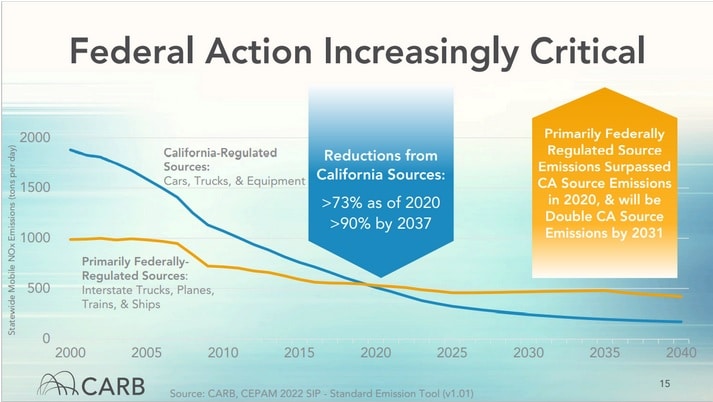California Adopts Strategy to Meet Federal Ozone Standard by 2037

The California Air Resources Board on Sept. 22 approved the 2022 State Implementation Plan, or SIP, strategy for reaching the federal health based standard for ozone emissions within the next 15 years. The net cost of the strategy is projected to be $96.2 billion, which involves $33.8 billion in board actions and $62.3 billion in measures that necessitate federal activities between 2023 and 2037, with an annual cost of $8.8 billion.
The Clean Air Act requires the U.S. Environmental Protection Agency to set standards for pollutants that are considered harmful to public health and the environment, and review them periodically. The agency must designate areas based on their attainment of the standard and develop plans to attain and maintain the standards. In 2015, the agency lowered the 8-hour ozone standard from 75 parts per billion, or ppb, to the more health protective level of 70 ppb.
The SIP details the control strategy to attain the federal standard of 70 ppb of ozone over an eight hour period. The board estimates the plan will accomplish more than 200 tons per day of nitrogen oxide and 40 tonnes per day of reactive organic gases emissions reductions statewide in 2037.
The strategy incorporates a range of actions to lessen emissions from suppliers under the state’s mandate using all structures accessible to shift away from combustion through rules along with incentive and voluntary plans. Strategies outlined in the plan include Advanced Clean Truck Measures, In-Use Locomotive Measure, a planned zero-emissions space and water heaters proposal and methods to reduce emissions from consumer products. The board held a vigorous public process over the past 14 months, in order to come up with the strategies, which involved early stakeholder engagement, four public meetings and an informational update to the board in February.
The board notes that 19 areas in the state are defined as nonattainment for federal ozone standard and seven regions require declines ahead of already-adopted state and local laws. For the remainder of this year and into the first half of 2023, the board will be contemplating regional strategy plans for the seven nonattainment regions requiring further emission cuts ahead of those defined in the 2022 State SIP Strategy. These plans will detect local actions that will balance the state, federal, and international measures recognized in the SIP strategy.
EnerKnol Pulses like this one are powered by the EnerKnol Platform—the first comprehensive database for real-time energy policy tracking. Sign up for a free trial below for access to key regulatory data and deep industry insights across the energy spectrum.
ACCESS FREE TRIAL